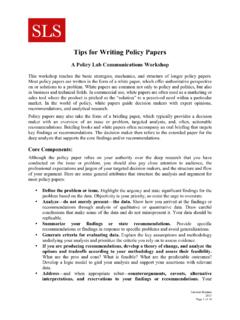Transcription of How To Write A Comprehensive Public Relations Plan
1 How To Write A Comprehensive Public Relations plan : Part 1 By Craig Miyamoto, APR, Fellow PRSA The Public Relations plan is one of the most important documents you will produce in your career. It has been said that Public Relations is the result of form and substance. While this is not exactly true, it does have some basis when you're trying to persuade your client or boss to let you spend their money. How you say it (form) and what you say (substance) will likely determine your success or failure in getting your proposal accepted. Let's face it, clients and bosses are impressed by the way things look -- just like you, they're only human. All other things being equal, a well-organized and attractively prepared proposal will win out every time. So, what can you do to help ensure success? Well, there are a number of elements in an effective Public Relations proposal presentation of which you must be aware.
2 Begin each section with the appropriate subheads: 1. Letter of transmittal 2. Executive summary 3. Situation analysis 4. Problem and consequences 5. Campaign goal 6. Audience identification and messages 7. Audience objectives 8. Strategies 9. Communication Tactics 10. Schedule 11. Budget 12. Evaluation plans 13. Pertinent research 14. Communication samples Each of these elements is vital. Each plays an important role in building a logical, well-planned proposal. A detailed discussion of each follows. Letter of transmittal This item is an adjunct to -- and precedes -- the actual plan . As simple as it may sound, you need to transmit your plan to the client or your boss. Standard accepted business practice dictates that you Write a letter or memorandum of transmittal. Limit the transmittal letter/ memo to a single page. If you are submitting the plan to a client, use the following format: A cordial opening paragraph stating that you are submitting "the attached plan for XXX campaign, as promised.
3 " Follow this with a brief description of the plan , including the campaign's "bottom line" -- income expectations, expenses, net "profit" or loss -- in other words, what your client is expected to lay out for the Public Relations campaign. A reference to the executive summary that follows. A statement that you either look forward to presenting the plan in person as a previously designated time and place, or will contact the client to arrange a meeting to discuss the plan . Gracious words of "thank you" for the opportunity to submit the plan . Two caveats: Spell the company's and client's names correctly, and double-check titles and addresses. You don't want two strikes against you before the client gets to the meat of your proposal. If you are submitting the plan to your boss, make sure to economize even further on your words. You can eliminate some of the opening and closing niceties.
4 Executive summary Also an adjunct to the plan , this is a summary of your proposed campaign that covers several key points most likely to interest the executive who reads your plan . Here is a suggested format of the executive summary: The Problem: State here what you believe the problem to be. Program Goal: State here what your ultimate goal is. Target Audiences: (1) Your primary audience, (2) your secondary (intervening) audience(s), and (3) your tertiary (special) audience(s). Audience Objectives: (1) What you expect your primary audience to do, (2) what you expect your intervening audience(s) to do, and (3) what you expect your special audience(s) to do. Major Strategy: State your major strategy here, listing the key tactics that you will use in your campaign. Recommended Budget: State your total anticipated income and sources, your anticipated expenses, and the anticipated net profit or loss.
5 Evaluation Plans: State how you expect to evaluate (and expect to know) whether or not you've achieved each of your campaign and audience objectives. Situation analysis The very first item in the plan itself should be an analysis of the current situation, based on results of your research. The situation analysis contains all of the information and data you collected about the internal and external environments. Depending on how much research is required and has been conducted, and how complicated and/or involved the organization's problems are, the situation analysis can run from one to three or more pages. While a problem statement directs the planning effort to a particular set of conditions, the situation analysis provides details about internal and external contexts. It includes a literature review (which requires a bibliography of sources).
6 The Situation Analysis: Information To Look For Internal factors: Statements of the organization's mission, charter, bylaws, history and structure. Lists, biographical sketches and photos of key individuals - officers, board members, and program managers. Detailed descriptions of programs, products, services, etc. Statistics about resources, budget, staffing and programs. Summaries of interviews with key personnel about the problem situation. Copies of policy statements and procedures related to the problem. Complete descriptions of how the organization currently handles the problem. Lists and descriptions of the organization's controlled communication media. External factors: Clippings from newspapers, magazines, trade publications, and newsletters tracing print media coverage of organization and problem situation.
7 Reports of radio, television and cable placements. Content analyses of media coverage. Lists of media, journalists, columnists, and free-lance writers who report news about the organization and related issues. Lists and descriptions of individuals and groups that share the organization's concerns, interests, and views (including their controlled print and broadcast media). Lists and descriptions of individuals and groups that oppose the organization's positions on the issues (including their controlled print and broadcast media). Survey results of Public 's awareness, knowledge, opinions, and behaviors related to the organization and problem situation. Schedules of special events, observances, and other important dates related to the organization and problem. Lists of government agencies, legislators, and officials with regulatory or legislative power affecting the organization and the problem situation.
8 Copies of relevant government regulations, legislation, bills pending, referenda, publications, and hearing reports. Copies of published research on topics related to the problem situation. Lists of important reference books, records, and directories, as well as their locations in the organization. When you Write the situation analysis, present your research findings in a logical and easily understood order. List results of client research, situational research, and audience research. If you have used the suggested outline above, you should have all of the necessary pertinent information you need. Assumptions No matter how much research you've done, something always seems to be missing. If you've done your homework well, you should have no assumptions to present here. In some cases, however, assumptions are inevitable and as a practical matter, unavoidable.
9 So, when you Write your situation analysis, you may need to make some assumptions about various aspects of the situation. If you must make assumptions, list them in a supplemental section, noting what missing information you can reasonably assume. "A friendly media" is not a valid assumption. Professionals never make assumptions, especially about the news media. Problem and consequences Based on your research, and particularly on your preliminary interviews with the client, you should be able to isolate the overriding problem, and determine what will happen if the problem is not solved. The problem statement itself should be concise and very specific. If possible, Write it in 25 words or less, using standard subject-verb-object order. This step is crucial to your plan and to the success of your campaign. Mess up here and you will end up 'way off course.
10 Think of the problem statement as your starting course to the moon. One degree to the left or right, up or down, and you'll miss the moon by thousands of miles. It's the same with the problem statement. Identify the wrong problems, and you may as well not even turn in your plan . Get to the root cause of your problem, and try to identify exactly what attitude (what they think) or behavior (what they do) you need to influence. Do you want attitudes crystallized, modified or reinforced? Be especially conscious of the ultimate behavior you want to evoke. Answer this question: "What exactly is it that we want them to do as a result of this campaign?" And yet, proper problem identification and statement is still not enough. The client may recognize that there is a problem, but unless there is a consequence - unless the client will lose something of value, whether it be profits, members, or quality of service -- the client may remain unconvinced about your plan .



